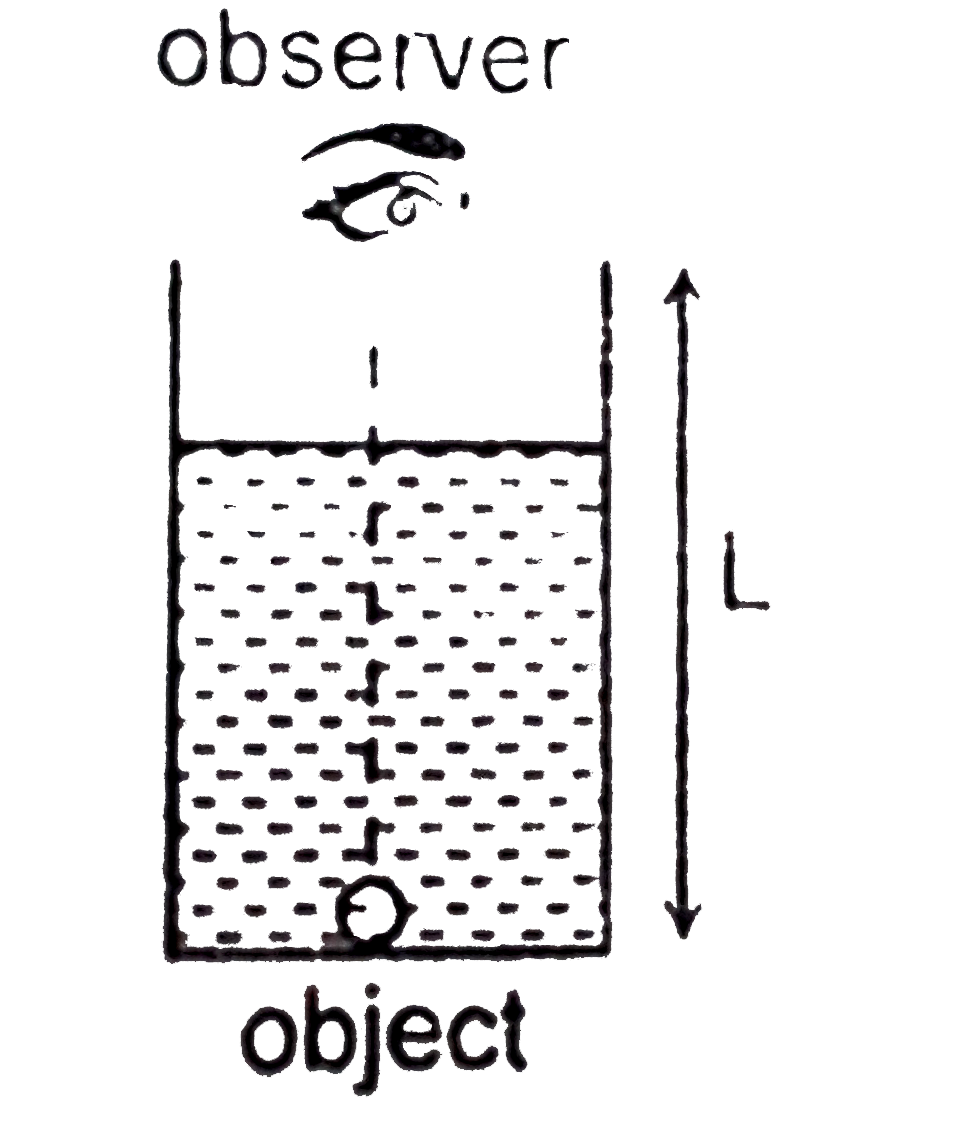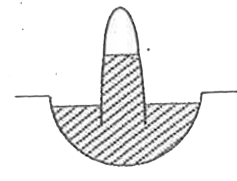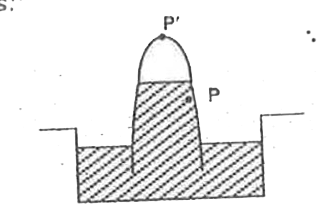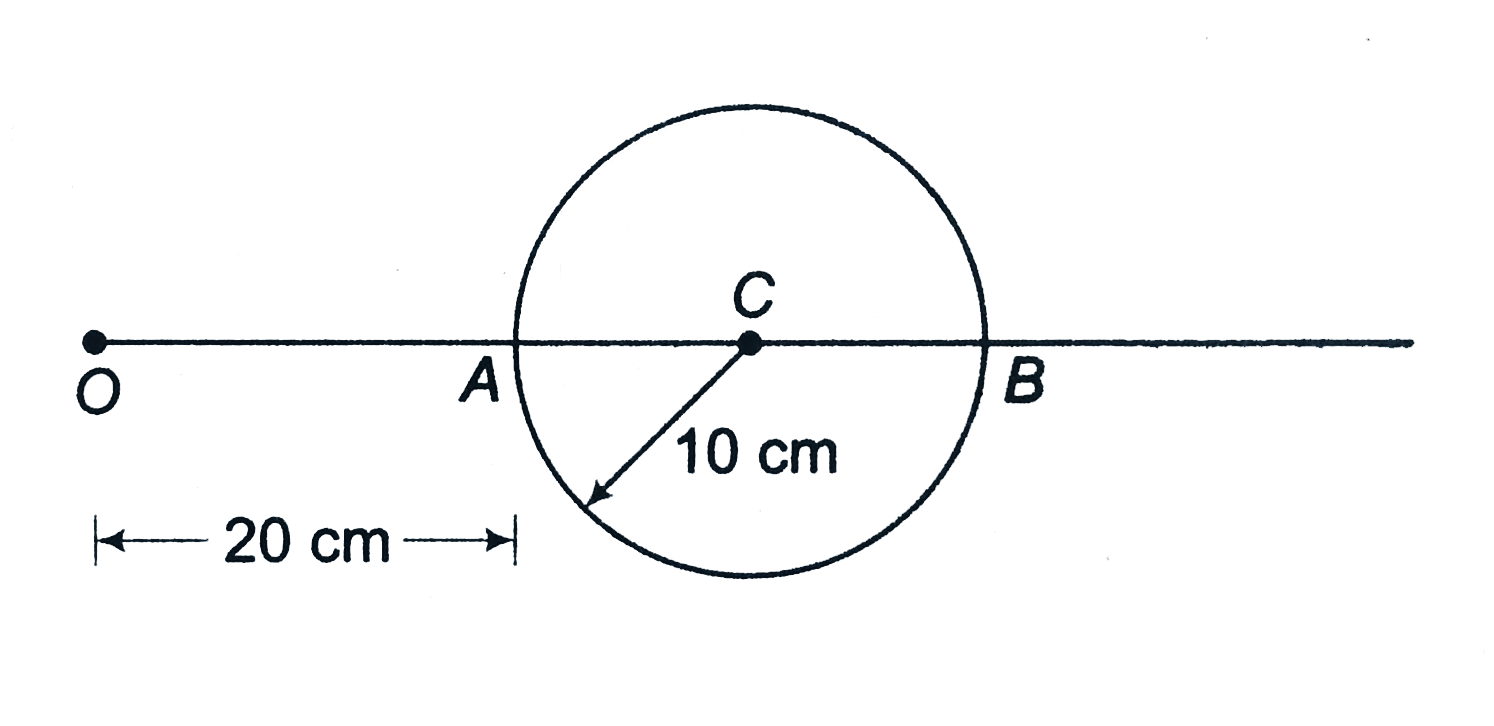Consider an extended object immersed in water contained in a plane trough. When seen from close to the edge of the trough, the object looks distorted because.
the apparent depth of the points close to the edge are nearer the surface of the water compared to the points away from the edge
the angle subtended by the image of the object at the eye is smaller than the actual angle subtended by the object in air
some of the points of the object far away from the edge may not be visible because of total internal relfection
water in a trough acts as lens and magnifies the object
To solve the question regarding why an extended object immersed in water looks distorted when viewed from the edge of a trough, we can break down the explanation into a series of logical steps:
1. Understanding the Setup:
- We have an extended object placed in water within a plane trough. The observer is viewing the object from the edge of the trough.
2. Refraction of Light:
- When light travels from water (a denser medium) to air (a rarer medium), it undergoes refraction. This bending of light occurs because of the change in speed as light moves between different media.
3. Normal Shift:
- As light rays emerge from the water, they bend away from the normal line at the water-air interface. This bending causes the apparent position of the object to shift upward, making it look distorted.
4. Real Depth vs. Apparent Depth:
- The actual depth of the object in water is called the real depth, while the depth at which the object appears to be located (due to refraction) is called the apparent depth. The apparent depth is always less than the real depth when viewed from above.
5. Distortion of the Image:
- Due to the bending of light rays, the angles at which the rays reach the observer are altered. This results in a smaller angle of incidence than the actual angle, causing the object to appear distorted.
6. Total Internal Reflection:
- Some light rays may hit the water-air boundary at angles greater than the critical angle, leading to total internal reflection. This means that those rays do not exit the water, further contributing to the distortion of the image. Points that would normally be visible may become obscured.
7. Conclusion:
- The combination of refraction, normal shift, and total internal reflection leads to the distortion of the image of the object when viewed from the edge of the trough.
- We have an extended object placed in water within a plane trough. The observer is viewing the object from the edge of the trough.
- When light travels from water (a denser medium) to air (a rarer medium), it undergoes refraction. This bending of light occurs because of the change in speed as light moves between different media.
- As light rays emerge from the water, they bend away from the normal line at the water-air interface. This bending causes the apparent position of the object to shift upward, making it look distorted.
- The actual depth of the object in water is called the real depth, while the depth at which the object appears to be located (due to refraction) is called the apparent depth. The apparent depth is always less than the real depth when viewed from above.
- Due to the bending of light rays, the angles at which the rays reach the observer are altered. This results in a smaller angle of incidence than the actual angle, causing the object to appear distorted.
- Some light rays may hit the water-air boundary at angles greater than the critical angle, leading to total internal reflection. This means that those rays do not exit the water, further contributing to the distortion of the image. Points that would normally be visible may become obscured.
- The combination of refraction, normal shift, and total internal reflection leads to the distortion of the image of the object when viewed from the edge of the trough.
Topper's Solved these Questions
- BOOK - NCERT EXEMPLAR ENGLISHCHAPTER - RAY OPTICS AND OPTICAL INSTRUMENTS EXERCISE - VERY SHORT ANSWER TYPE QUESTIONS16videos
RAY OPTICS AND OPTICAL INSTRUMENTS
- BOOK - NCERT EXEMPLAR ENGLISHCHAPTER - RAY OPTICS AND OPTICAL INSTRUMENTS EXERCISE - VERY SHORT ANSWER TYPE QUESTIONS16videos
RAY OPTICS AND OPTICAL INSTRUMENTS
- BOOK - NCERT EXEMPLAR ENGLISHCHAPTER - NUCLEIEXERCISE - Long answer type question10videos
NUCLEI
- BOOK - NCERT EXEMPLAR ENGLISHCHAPTER - SEMICONDUCTOR ELECTRONICS: MATERIAL,DEVICES AND SIMPLE CIRCUITEXERCISE - Multiplel choice questions26videos
SEMICONDUCTOR ELECTRONICS: MATERIAL,DEVICES AND SIMPLE CIRCUIT
Similar Questions
A cylinder is filled with a liquid of refractive index μ. The radius of the cylinder is decreasing at a constant rate K. The volume of the liquid inside the container remains constant at V. The observer and the object O are in a state of rest at a distance L from each other. When radius of cylinder is r the apparent velocity of the object as seen by the observer is
 View Solution
View SolutionA stone has a mass of 108.5 g. When the stone is totally immersed in water contained in a measuring cylinder, it displaces water from 50 cm3 to 93cm3. Find the density of the stone.
View SolutionOne end of a cylindrical glass rod (mu = 1.5) of radius 1.0 cm is rounded in the shape of a hemisphere. The rod is immersed in water (mu= 4/3) and an object is placed in the water along the axis of the rod at a distance of 8.0 cm from the rounded edge. Locate the image of the object.
View SolutionA copper piece of mass 88 g when immersed completely into water contained in a measuring cylinder, raises the level of water from 15 mL to 25 mL. Find the volume of copper piece
View SolutionWhen an illuminated object is held in front of a thick plane glass mirror, several images are seen, out of which the second image is brightest. Give reason.
View SolutionA copper piece of mass 88 g when immersed completely into water contained in a measuring cylinder, raises the level of water from 15 mL to 25 mL. Find the density of copper.
View SolutionTorricelli was the first do devise an experiment for measuring atmospheric pressure . He took calibrated hard glass tube , 1 m in lengt and of uniform cross section , closed at one end . He filled the whole tube with dry mercury taking care than no air or water droplets remain inside the tube , closed the opposite end of the tube tightly with thumb and inverted it . He put this inverted mercury tube into a mercury through , taking care that the end of the tube remains inside the mercury through , An interesting thing was noticed . Mercury in the tube fell down at first and then stopped at a particular position . The height was 76 cm above the free surface of mercury in the through . When the given tube was inclined or lowered in the mercury trough , the vertical haight of mercury level in the tube was always found constant .
Torricelli explained this by saying that the free surface of mercury in the trough . Hence , the hydrostatic pressure exerted by the trough measures the atmospheric pressure .

If this expriment uses water instead of mercury , then
A. length of water will be equal to 76 cm
B. length of water will be less than 76 cm
C. length of water will be greater than 76 cm
D. none of the aboveView SolutionTorricelli was the first do devise an experiment for measuring atmospheric pressure . He took calibrated hard glass tube , 1 m in lengt and of uniform cross section , closed at one end . He filled the whole tube with dry mercury taking care than no air or water droplets remain inside the tube , closed the opposite end of the tube tightly with thumb and inverted it . He put this inverted mercury tube into a mercury through , taking care that the end of the tube remains inside the mercury through , An interesting thing was noticed . Mercury in the tube fell down at first and then stopped at a particular position . The height was 76 cm above the free surface of mercury in the through . When the given tube was inclined or lowered in the mercury trough , the vertical haight of mercury level in the tube was always found constant .
Torricelli explained this by saying that the free surface of mrcury in the trough . Hence , the hydrostatic pressure exerted by the trough measures the atmospheric pressure .

If a small hole is made at point P in the barometer tube , then
 View Solution
View SolutionTorricelli was the first do devise an experiment for measuring atmospheric pressure . He took calibrated hard glass tube , 1 m in lengt and of uniform cross section , closed at one end . He filled the whole tube with dry mercury taking care than no air or water droplets remain inside the tube , closed the opposite end of the tube tightly with thumb and inverted it . He put this inverted mercury tube into a mercury through , taking care that the end of the tube remains inside the mercury through , An interesting thing was noticed . Mercury in the tube fell down at first and then stopped at a particular position . The height was 76 cm above the free surface of mercury in the through . When the given tube was inclined or lowered in the mercury trough , the vertical haight of mercury level in the tube was always found constant .
Torricelli explained this by saying that the free surface of mercury in the trough . Hence , the hydrostatic pressure exerted by the trough measures the atmospheric pressure .
If an additional hole is also made at P ' at the top point of the tube , then

A. mercury will not come out of the tube
B. mercury may come out of the tube after some time .
C. mercury will come out of the tube instantly
D. none of theseView SolutionA glass sphere of radius R=10cm is kept inside water. A ponit object O is placed at 20cm from A as shown in figure. Find the position and nature of the image when seen from other side of the sphere. Also draw the ray diagram. Given, μg=3/2 and μw=4/3
 View Solution
View Solution

